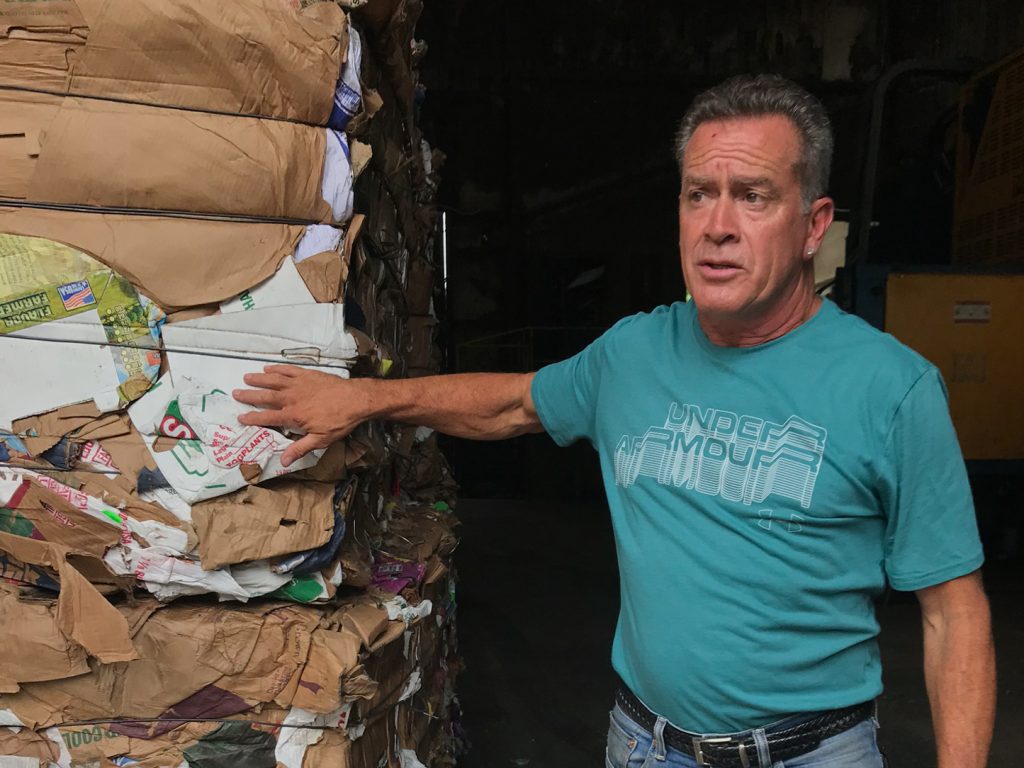News

More U.S. Towns Are Feeling The Pinch As Recycling Becomes Costlier
By: Rebecca Davis | NPR
Posted on:
When curbside recycling caught on in the 1970s, it was mostly about cans, glass, cardboard and paper. That’s how Donald Sanderson remembers it.
Sanderson is 90 years old, an earnest man with a ready smile. Every Thursday in Woodbury, N.J., where he lives, he hauls a big blue recycling bin out to the curb. Recycling is close to his heart. “I guess you could say I’m the father of recycling,” he says. “I don’t know if that’s good or bad.”
In the late 1970s, most trash just went to the local landfill, which cost Woodbury a lot of money in fees. And the landfill was filling up. Sanderson, who was on the City Council at the time, came up with an idea: There was a market for some of that trash — there were companies that would buy and reuse it.
So Sanderson suggested people should have to sort their waste and put glass, metal and paper out on the curb for pickup.

“They dumped trash on my lawn,” he recalls with a laugh. “I would open the door — and they would dump it the night before — and when I’d come out in the morning, I’d see what was there.” But, he says, “it didn’t really bother me. It made me more determined to make the program a success.”

Woodbury even started making money by selling its trash to companies that would recycle it.
That was nearly 40 years ago. More and more, that scenario has flipped: Communities are now having to pay to get rid of their rubbish. It’s happening in Woodbury and in places all over the country.
But back when recycling began to catch on, it was a godsend to local communities. As Americans bought more goods, there was ever more stuff to throw away — cardboard, glass, metal and, increasingly, plastic. Scrap was valuable. A global market grew around it, especially in China.
To encourage people to recycle more, communities in the 1990s started having residents put all their trash into one bin. It was called single-stream recycling.
“Good concept in theory, if it had worked the way it was supposed to,” says Monica Gismondi, the recycling coordinator in Gloucester County, where Woodbury is located. She says single stream has been a disaster for the facilities that accept and sort household trash destined for recycling — people started putting everything into their recycling bins. “They were getting the rubber hoses in there and literally the kitchen sink and the bathroom toilets and the bowling balls,” she says.
And a lot more plastic was showing up, everything from soda and water bottles to plastic grocery bags and shampoo bottles and food wrap. A lot of it couldn’t — and still can’t — be recycled. “That seems to be the biggest change over the last, say, 20 years,” Gismondi says. “How everything is going into a plastic container.”
Now plastic has become the biggest thorn in the side of the recycling industry and one for which taxpayers are more often footing the bill.
At Omni Recycling, a materials recovery facility in Pitman, N.J., one can see firsthand the mess that plastic has become for recyclers.
Recycling trucks from Woodbury and other towns stream in and out. Front-end loaders shovel mounds of trash onto the floor and then onto conveyor belts. It’s very, very loud. Piles of trash roll by on the belts. Optical sorters use laser beams to identify what objects are made of. Blasts of air separate them.
Like any other materials recovery facility, Omni is trying to separate the material it can sell, like plastic bottles (known by their plastic IDs as “1s” and “2s”), from what it can’t, like plastic bags.
Kevin Carducci, who is part owner and plant manager of Omni, points to an enormous pile of plastic bags. “That came off the system in the last four hours,” he says. “The screens get cleaned three times a day to remove all those plastic bags.” And that’s just the bags. Then there are the other nonrecyclables: pouches, film wrap, chip bags, Styrofoam, some tubs and clamshells, PVC pipes, plastic toys.

“It cost over a million dollars last year to remove all this residue and bags,” he says.
To recoup those costs, Carducci bills the towns he serves to process and dispose their trash. So the days when Woodbury got paid for its recyclables are gone. Like many communities in the U.S., Woodbury now has to pay materials recovery facilities to take its waste.
Materials recovery facilities in the U.S. used to sell a lot of plastic waste to China, which was willing to sort through it. But the nonrecyclables ended up making a huge mess both on land and in the ocean. So last year, China stopped buying most of it, and now materials recovery facilities in the U.S. are left holding the bag, literally.
Carducci says his profit margin is paper thin. Most of his revenue comes from recycling bottles, but it’s harder to make money on bottles, because they keep getting thinner. “It takes six times the amount of bottles, countwise, to get the same pound [of recyclable plastic] as you did years ago,” he says.
According to the recycling industry, only about 9% of plastic waste in the U.S. gets recycled every year (and probably less now, since China is no longer importing as much of it).
Meanwhile, it’s nearly as cheap for towns like Woodbury just to dump plastic waste into landfills as it is to send plastic waste off for recycling.
Carducci says the situation won’t change unless the companies that make all that plastic packaging start making more of it recyclable.
“It’s on them,” he says.
9(MDI4ODU1ODA1MDE0ODA3MTMyMDY2MTJiNQ000))

